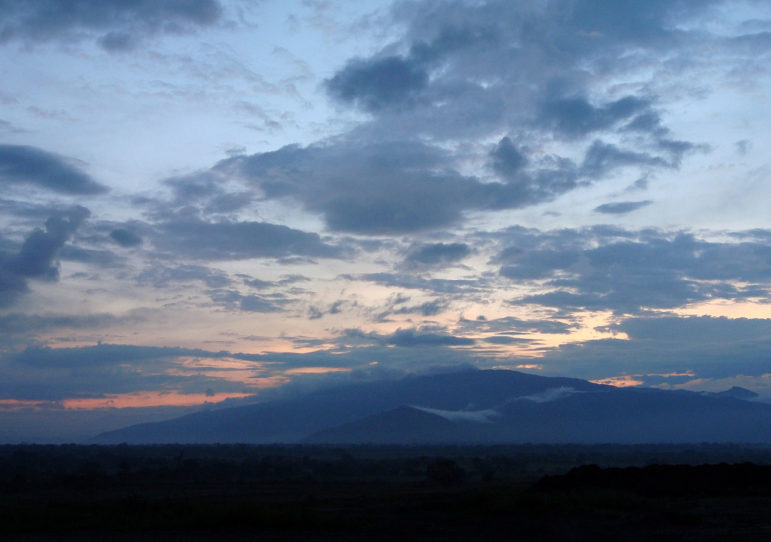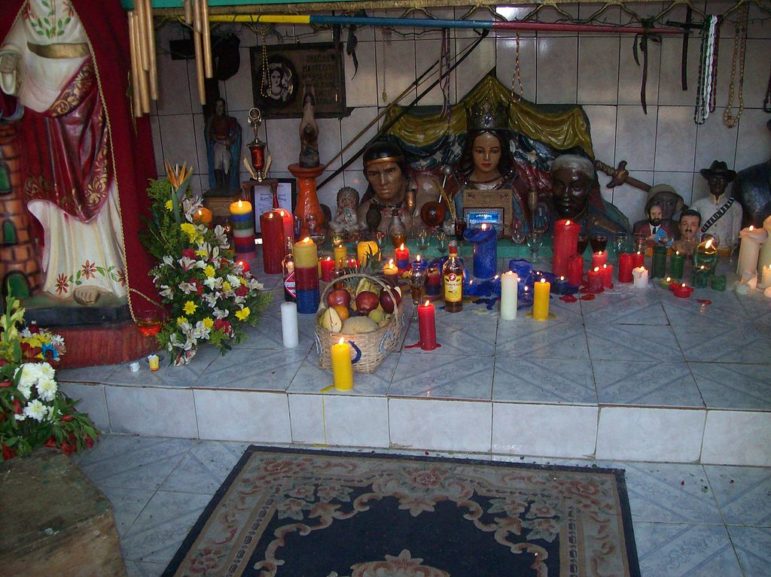
I discovered magic, spells, rituals, and the whole world of Witchcraft when I was in high school, although I was interested in mythology and legends since I was a child. Every time I entered an esoteric shop, known here in Venezuela as perfumerías esotéricas, “esoteric perfumeries,” there was an image present, a woman with two men. I didn’t pay it much attention, but as time went on and as I continued to see her, my curiosity was inevitable. It was María Lionza, the Venezuelan Queen of Spirits.
I want to make it clear that I have never had an experience with this figure, but a very good friend of my family has. She is a woman of my total trust that I prefer to keep anonymous, someone who has worked con la señora, “with the lady,” as she herself said, and who clarified many doubts and questions about María Lionza. To her, thank you very much!
Who is this Queen?
According to legend – although different versions abound – Yara was an indigenous princess, daughter of a cacique, an indigenous chief of the region, now the state Yaracauy. She was born during sometime during the 15th or 16th century, and was sent to live in the Montaña del Sorte, where an anaconda fell in love with her and devoured her. Terrified, Yara asked the mountain and its spirits for help, so Yara disintegrated and became one with the mountain. Some versions say that the anaconda swelled until it exploded, turning into rain.
Yara became a symbol of freedom, wisdom, and power, and she was chosen as the Queen of the Spirits. She also governs the flora, fauna, and waters. According to some, during the Venezuelan colonial era (approximately 1600-1810), Yara took the name of Santa María de la Onza Talavera del Prato de Nívar, or simply Santa María de la Onza, which was abbreviated to María Lionza. However, this seems to me an attempt to convert this indigenous figure to Catholicism.

Sorte, or Cerro María Lionza [Luisovalles, Wikimedia Commons, CC 3.0]
The Sorte Mountain, officially named “Cerro María Lionza Natural Monument,” is the center of her worship and a sacred place where the main altar to Queen María Lionza is located. As an estimated 10% and 30% of the national population is devoted to her, the mountain is held in high esteem and respect, to the point that then-President Rómulo Betancourt declared it a monument on March 18, 1960.
The Courts of the Queen
In the cult of María Lionza, also called Espiritismo Marialioncero, Marialioncero Spiritism, she is the figure who presides over all the magical works, rituals, and ceremonies, and to whom offerings are made. She is even called a goddess, although it is always emphasized that she is better known as Queen María Lionza. Her importance lies in that she commands the legions of spirits, known as “cortes,” and it is she and only she who allows the passage of the spirits to the earthly plane to interact with the living, either through portals or during ceremonies or magical works, where devotees lend their bodies for these entities. In Venezuela, this is called ser materia, “being matter.”

Altar to María Lionza [Geliersanta, Wikimedia Commons, CC 3.0]
At all times, the image of María Lionza is present in the center of the altar, almost always as a bust, accompanied by two characters: the cacique Guaicaipuro, who fought against the Spanish and leads la Corte Indígena, the Indigenous Court, and Negro Felipe, who fought during the Venezuelan War of Independence, being the leader of la Corte Negra. The three of them are the most important figures of the cult, and they are known as Las Tres Potencias, “The Three Powers,” with the Queen always in the middle.
The courts, in a nutshell, are legions of spirits led by a prominent figure who is also at the service of María Lionza, each with a specific objective or “topic,” such as la Corte de los Médicos, led by Dr. José Gregorio Hernández; la Corte Libertadora, with Simón Bolívar at its head; la Corte Chamarrera, made up of wise men from the countryside, headed by Don Nicanor Ochoa; la Corte Malandra, a colloquial and very informal word synonymous with criminals, who almost always come from the lower social strata; and la Corte Celestial, la Corte de los Estudiantes, and even la Corte Vikinga, the Viking Court.
When one of these spirits enters the person, he or she acquires their way of speaking and acting as long as the spirit remains in their body, so the identity of the spirit or at least to which court it belongs becomes evident. However, the person in question does not retain any memory of the experience, since they enter in a kind of deep sleep.
The pilgrimage
On October 12, the Day of Indigenous Resistance, known as Día de la Raza until 2002, is celebrated in Venezuela. It commemorates the struggles of native peoples against Spanish colonizers. On this date, the devotees of María Lionza make a pilgrimage to the Montaña del Sorte in Yaracuy, in the north of the country.
On this day, the Queen is honored, the curious and willing to participate have the opportunity to do so for the first time, and devotees go into a trance to contact the various spirits, almost always through tobacco, an essential element in practice. This is used for cleaning one’s self, cleaning others, cleaning the space, receiving visions, and more uses.
Tobacco serves as a form of offering, but flowers are much more popular for this use, and they are almost always what devotees leave as a token of respect and gratitude after a request or “milagro” is fulfilled. The sculpture of María Lionza located on the Francisco Fajarda Highway in Caracas, where she is seen naked on top of a tapir, also usually has floral offerings. Wine is another option that is sometimes considered.

Statue of María Lionza in Caracas, Venezuela [ruurmo, Wikimedia Commons, CC 2.0]
A bóveda, a vault, is commonly made. It is a kind of altar that must be mounted on a table; it carries precise elements, and should not be set on the floor. The image of María Lionza is always in the middle, along with Guaicaipuro and Negro Felipe. Bóvedas are also often included when offering a mass, which, contrary to what I originally believed, does include the Catholic-Christian figure of God, only the mass itself is directed towards the Queen.
The image of the Queen today
As a figure, María Lionza seems to me more than just fascinating. Her history is full of feminine empowerment and sacred femininity, and is strongly related to themes such as freedom, healing, and justice. It has strong roots in the indigenous beliefs of Venezuela, but without neglecting the cultural amalgam that characterizes this country.
A couple of months ago, when the quarantine began in Venezuela, a high school classmate told several of us that he was in Yaracuy attending conferences, and was alarmed by the number of brujos and devotees. He said it was something horrible to look at, and he was eager to get out of there.
While I was growing up, I also heard those kinds of comments – some positive, but many negative, in which I was told that going to the mountain was dangerous and that it was preferable not to get even close to it. But knowing better the history surrounding Queen María Lionza, what she represents, and her customs, it is obvious to me that hers is not a harmful cult.
There are elements I do not feel identified with, such as the use of tobacco, essential for interaction with spirits and the development of faculties, but the following of the Queen of Spirits is still a belief with beautiful values and messages that, in my opinion, Venezuelan society needs so much. Our society can be very prejudiced; it prefers to judge from a comfortable position, instead of entering, at least for a moment, the court of a Queen who has even captivated the singers Rubén Blades and Willie Colón – they dedicated her a song with her same name in 1978.
The Wild Hunt always welcomes submissions for our weekend section. Please send queries or completed pieces to eric@wildhunt.org.
The views and opinions expressed by our diverse panel of columnists and guest writers represent the many diverging perspectives held within the global Pagan, Heathen, and polytheist communities, but do not necessarily reflect the views of The Wild Hunt Inc. or its management.
The Wild Hunt is not responsible for links to external content.
To join a conversation on this post:
Visit our The Wild Hunt subreddit! Point your favorite browser to https://www.reddit.com/r/The_Wild_Hunt_News/, then click “JOIN”. Make sure to click the bell, too, to be notified of new articles posted to our subreddit.